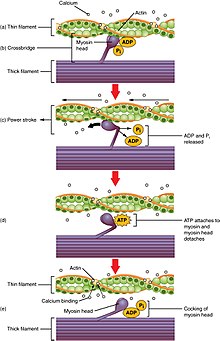User:Mguarino22/sandbox
Like all proteins, the unique amino acid arrangement in the primary sequence of GLUT4 are what allow it to transport glucose across the plasma membrane. In addition to the phenylalanine on the N-terminus, two Leucine residues and acidic motifs on the COOH-terminus are believed to play a key role in the kinetics of endocytosis and exocytosis. [1]
In striated muscle cells, GLUT4 concentration in the plasma membrane can increase as a result of either exercise or muscle contraction.
During exercise, the body needs to convert glucose to ATP to be used as energy. As G-6-P concentrations decrease, hexokinase becomes less inhibited, and the glycolytic and oxidative pathways that make ATP are able to proceed. This also means that muscle cells are able to take in more glucose as its intracellular concentrations decrease. GLUT4 is the primary transporter for facilitated diffusion of glucose into the cell. [2]
Although muscle contractions function in a similar way and also induce the translocation of GLUT4 into the plasma membrane, the two processes obtain different elements of intracellular GLUT4, either positive or negative. GLUT4-positive elements are utilized during insulin stimulation, while the negative elements are active during contractions.[3]
Adipose tissue, commonly known as fat,[4] is a depository for energy in order to conserve metabolic homeostasis. As the body takes in energy in the form of glucose, some is expended, and the rest is stored as glycogen primarily in adipose tissue and liver or muscle cells. [5]
As we eat and glucose levels increase, insulin is released from the pancreas and into the blood stream.[6] Increased insulin levels cause the uptake of glucose into the cells. GLUT4 is stored in the cell in transport vesicles, and is quickly incorporated into the plasma membrane of the cell when insulin binds to membrane receptors. [5]
An imbalance in glucose intake and energy expenditure has been shown to lead to both adipose cell hypertrophy and hyperplasia, which lead to obesity.[7] In addition, mutations in GLUT4 genes in adipocytes can also lead to increased GLUT4 expression in adipose cells, which allows for increased glucose uptake and therefore more fat stored. If GLUT4 is over-expressed, it can actually alter nutrient distribution and send excess glucose into adipose tissue, leading to increased adipose tissue mass. [7]
Cardiac muscles are slightly different from skeletal muscles. As rest, they prefer to utilize fatty acids as their main energy source. As activity increases and it begins to pump faster, the cardiac muscles begin to oxidize glucose at a higher rate. [8]
An analysis of mRNA levels of GLUT1 and GLUT4 in cardiac muscles show that GLUT1 plays a larger role in cardiac muscles than it does in skeletal muscles.[9] GLUT4, however, is still believed to be the primary transporter for glucose. [10]
Much like in other tissues, GLUT4 also responds to insulin signaling, and is transported into the plasma membrane to facilitate the diffusion of glucose into the cell. [11]

 | This is a user sandbox of Mguarino22. You can use it for testing or practicing edits. This is not the sandbox where you should draft your assigned article for a dashboard.wikiedu.org course. To find the right sandbox for your assignment, visit your Dashboard course page and follow the Sandbox Draft link for your assigned article in the My Articles section. |
- ^ Huang, Shaohui; Czech, Michael (4 April 2017). "The GLUT4 Glucose Transporter". Cell Metabolism. 5.
- ^ Richter, Erik A.; Hargreaves, Mark (2013-07-01). "Exercise, GLUT4, and Skeletal Muscle Glucose Uptake". Physiological Reviews. 93 (3): 993–1017. doi:10.1152/physrev.00038.2012. ISSN 0031-9333. PMID 23899560.
- ^ Ploug, Thorkil; Deurs, Bo van; Ai, Hua; Cushman, Samuel W.; Ralston, Evelyn (1998-09-21). "Analysis of GLUT4 Distribution in Whole Skeletal Muscle Fibers: Identification of Distinct Storage Compartments That Are Recruited by Insulin and Muscle Contractions". The Journal of Cell Biology. 142 (6): 1429–1446. doi:10.1083/jcb.142.6.1429. ISSN 0021-9525. PMID 9744875.
- ^ "Adipose tissue". ScienceDaily. Retrieved 2017-05-23.
- ^ a b Favaretto, Francesca; Milan, Gabriella; Collin, Gayle B.; Marshall, Jan D.; Stasi, Fabio; Maffei, Pietro; Vettor, Roberto; Naggert, Jürgen K. (2014-10-09). "GLUT4 Defects in Adipose Tissue Are Early Signs of Metabolic Alterations in Alms1GT/GT, a Mouse Model for Obesity and Insulin Resistance". PLoS ONE. 9 (10). doi:10.1371/journal.pone.0109540. ISSN 1932-6203. PMC 4192353. PMID 25299671.
{{cite journal}}: CS1 maint: PMC format (link) CS1 maint: unflagged free DOI (link) - ^ "Insulin Synthesis and Secretion". www.vivo.colostate.edu. Retrieved 2017-05-23.
- ^ a b Shepherd, P. R.; Gnudi, L.; Tozzo, E.; Yang, H.; Leach, F.; Kahn, B. B. (1993-10-25). "Adipose cell hyperplasia and enhanced glucose disposal in transgenic mice overexpressing GLUT4 selectively in adipose tissue". The Journal of Biological Chemistry. 268 (30): 22243–22246. ISSN 0021-9258. PMID 8226728.
- ^ Morgan, H. E.; Henderson, M. J.; Regen, D. M.; Park, C. R. (1959-09-25). "Regulation of glucose uptake in heart muscle from normal and alloxan-diabetic rats: the effects of insulin, growth hormone, cortisone, and anoxia". Annals of the New York Academy of Sciences. 82: 387–402. ISSN 0077-8923. PMID 14424107.
- ^ Laybutt, D. R.; Thompson, A. L.; Cooney, G. J.; Kraegen, E. W. (1997-09-01). "Selective chronic regulation of GLUT1 and GLUT4 content by insulin, glucose, and lipid in rat cardiac muscle in vivo". American Journal of Physiology - Heart and Circulatory Physiology. 273 (3): H1309 – H1316. ISSN 0363-6135. PMID 9321820.
- ^ Rett, K.; Wicklmayr, M.; Dietze, G. J.; Häring, H. U. (1996-01-01). "Insulin-Induced Glucose Transporter (GLUT1 and GLUT4) Translocation in Cardiac Muscle Tissue Is Mimicked by Bradykinin". Diabetes. 45 (Supplement 1): S66 – S69. doi:10.2337/diab.45.1.S66. ISSN 0012-1797.
- ^ Slot, J. W.; Geuze, H. J.; Gigengack, S.; James, D. E.; Lienhard, G. E. (1991-09-01). "Translocation of the glucose transporter GLUT4 in cardiac myocytes of the rat". Proceedings of the National Academy of Sciences. 88 (17): 7815–7819. ISSN 0027-8424. PMC 52394. PMID 1881917.
{{cite journal}}: CS1 maint: PMC format (link) - ^ Lodish, Harvey; Berk, Arnold; Zipursky, S. Lawrence; Matsudaira, Paul; Baltimore, David; Darnell, James (2000). "Oxidation of Glucose and Fatty Acids to CO2".
{{cite journal}}: Cite journal requires|journal=(help)
